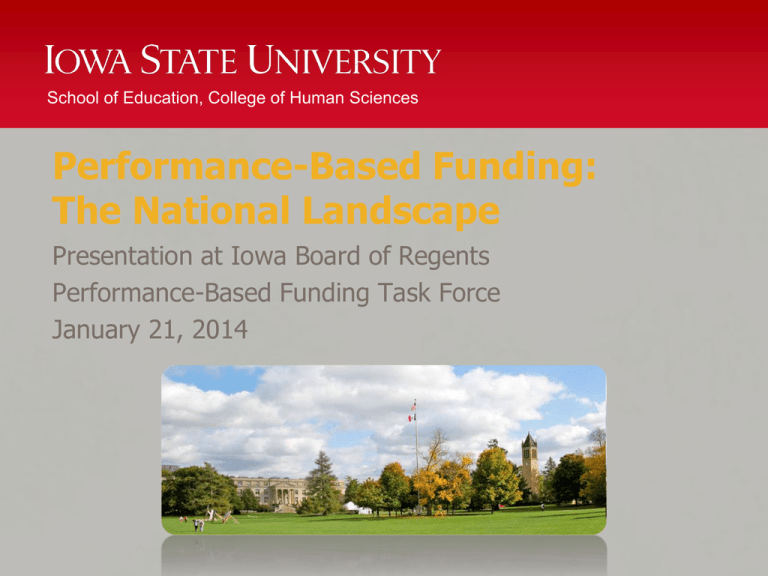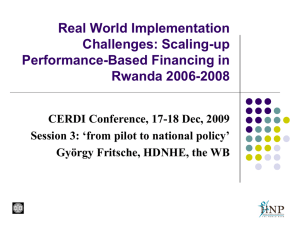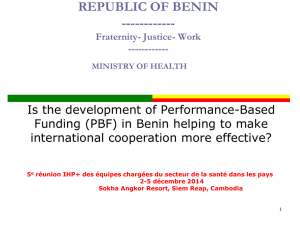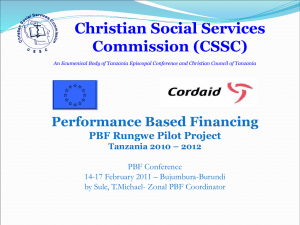Performance-Based Funding: The National Landscape Presentation at Iowa Board of Regents
advertisement

School of Education, College of Human Sciences Performance-Based Funding: The National Landscape Presentation at Iowa Board of Regents Performance-Based Funding Task Force January 21, 2014 Presenters Janice Nahra Friedel, PhD Associate Professor School of Education College of Human Sciences Iowa State University Zoë Mercedes Thornton Doctoral Candidate, Higher Education Iowa State University The recession and decline in state revenues has caused a shift in the proportion of public college revenues generated from state aid to tuition and fees. Many policymakers are no longer satisfied with providing incremental funding increases or using enrollment-driven formulae for public colleges and universities. Increasing accountability coupled with declining revenues has led many states to implement strategies to hold colleges accountable in meeting state needs and to ensure quality. These strategies range from uniform performance indicators to performance-based funding (PBF). PBF is a key policy response to the call for greater transparency and accountability in public higher education. What is PBF? • “A system based on allocating a portion of a state’s higher education budget according to specific performance measures.” (Miao, 2012, p. 1) • (PBF) “rewards institutions that meet state goals,…is based on outputs instead of inputs,…(and) the more goals that institutions meet, the more funding they receive.” (Blankenberger, 2011, slide 12) Brief History of PBF • • • The first state to attempt PBF was Tennessee in 1979, and as many as 30 states have implemented PBF or some consideration of performance in budgeting processes (Burke & Modarresi, 1999) Typical percentage of funding allocated based on performance ranged from 1-5% (Sanford & Hunter, 2011) South Carolina was the most extreme early example – 37 performance indicators and 100% of public funding (Alexander, 1998) Three Models of PBF • Output-based Funding Formula • • Performance Set-asides • • Fiscal incentives for positive improvement in specific metrics. Utilized within the state funding formula as a portion of the annual base appropriations. Often weighted for institutional mission. Allows institutions to increase their total appropriations through improved performance on identified metrics. A percentage of the state funding is reserved to be awarded to high performing institutions. May be a portion of the annual base appropriation or separate bonus funding. Institutions compete with each other for the set-aside funding by achieving a targeted measure of performance set prior to the year. Performance Contracts • Funding is awarded if the institution meets the previously agreed upon performance goals set forth in the contract with the state. (Miao, 2012) Types of Performance Indicators • General outcome indicators: graduation rate, number of • Progress outcome indicators: number of students • Subgroup outcome indicators: low-income status, at-risk • High-need subject outcome indicators: STEM fields, degrees/certificates awarded, number of degrees/certificates awarded per FTE, research or grant funding awarded, job placement rates, student success on licensing exams completing 12, 24, 48 and 72 semester credits, developmental course completion, retention rates, gateway course completion, course completion after transfer, dual enrollment credit completion status, Pell Grant recipients, nontraditional students, first-generation students, minority group identification nursing, job placement rates in high-need fields (Dougherty & Reddy, 2011; Harnisch, 2011; Miao, 2012; NCSL, 2013; WHECB, 2011) Comparing Design Types PBF 1.0 PBF 2.0 • Often designed without input from higher education leaders • • • Institutional goals and mission disregarded • • Emphasis on outcomes measures, minor attention to progress measures • Small percentage of bonus funding - often new money • • • Joint planning process Alignment with the state’s agenda and institutional priorities Soft landing: learning year and/or stop loss Progress and completion measures Weighted formula to ensure access and equity Percentage of base appropriations Performance-Based Funding: The National Landscape Policy Brief http://www.uaedpolicy.ua.edu/uploads/2/1/3/2/21326282/pbf_9-17_web.pdf PBF is a Moving Target Updates to PBF State Activity Table STATE STATUS Alabama UPDATED: 12-20-2013 Hawai’i UPDATED: 11-17-2013 Formal discussions Iowa UPDATED: 10-17-2013 Kansas UPDATED: 10-13-2013 Formal Discussions In place 2008 HB2978 In place Statute 74-3202d Performance agreements AMOUNT OF PERFORMANCE BASED FUNDING Up to 2% of annual appropriations New funds, in excess of total appropriations received the previous fiscal year, are available for performance funding METRICS The Alabama Department of Postsecondary Education (overseeing community and technical colleges) commissioned a study in 2013 to propose a new funding formula to allocate state appropriations. Using 5 year averages as baseline data, public universities and community colleges metrics include the following: Number of transfer students Number of graduates Number of job placements in major workforce shortage areas The Board of Regents has formed a Task Force to review the effectiveness of the current funding formula. Performance-based funding options will be discussed. Institutions submit performance agreements every three years, which are evaluated annually for funding. Performance indicators for all sectors include: First year to second year retention rates Number of certificates and degrees awarded Graduation rates Student performance on institutional assessments or quality measures. Additional sector-specific measures are also in place. Public universities: STEM field degrees and certificates Peer-related quality measures Selected regional and national rankings Community and technical colleges: Percentage of employed and transferred students Graduate wages Third-party technical credentials State Activity PBF Activity Number of States PBF in Place 25 Transitioning to PBF 5 Formal Discussions of PBF 10 No Formal Activity Found 10 Updated from Friedel, Thornton, D'Amico & Katsinas (2013). Current PBF Status Across the States PBF In Place Transitioning to PBF Formal Discussions of PBF No Formal Activity Found Updated from Friedel, Thornton, D'Amico & Katsinas, 2013. Future Updates • National Conference of State Legislatures • http://www.ncsl.org/research/education/perf ormance-funding.aspx Proposed Advantages • • • • Increased awareness and alignment of the institutional mission and goals with the state’s agenda Increased college selfawareness of actual outcomes Increased healthy competition between colleges Increased use of data during institutional planning and decision making Possible Disadvantages • • • • Indicators measure only a portion of the entire institutional picture Potential negative effects on institutional quality, access, equity, mission, or stability Potential for additional loss of funds Disregard for institutionspecific factors PBF Policy Recommendations • Engage stakeholders in the discussion and planning • Align the measures with the state agenda, particularly workforce and economic development goals • Allow for the differentiation of institutional missions • Phase in the new model and funding with a “soft landing” • Commit solid and significant state dollars to incentivize the PBF system • Include both outcome and progress measures • Continuously evaluate the PBF system and formula A Note of Caution • It is important to note that PBF is not the answer to the larger issue of declining support and funding for higher education, and thus should not be used to meet the greater funding issues of higher education. A PBF Bandwagon? • Despite recent attention, there is not compelling evidence of the link between PBF and improved student outcomes at this time. PBF Questions for Further Study • • • • • • Does PBF work? What are the impacts of PBF on institutional policy? Impacts on institutional practice? What are the impacts of PBF on students? Impacts on programs? What organizational changes are made in response to state PBF policy? How is state PBF policy assessed and evaluated? How does PBF influence other state higher education policy? References • • • • Alexander, F. K. (1998, November). The endless pursuit of efficiency: The international movement to increase accountability and performance in higher education. Paper presented to the Annual Meeting of the Association for the Study of Higher Education, Miami, FL. Blankenberger, B. (2011). Performance-based funding and higher education institutions in the state of Illinois. Presented at the Illinois Association of Institutional Research Conference, November 2011. Burke, J. C., & Modarresi, S. (1999). Performance funding and budgeting: Popularity and volatility--the third annual survey. Albany, NY: Nelson A. Rockefeller Institute of Government, Public Higher Education Program. Dougherty, K. J., & Reddy, V. (2011). The impacts of state performance funding systems on higher education institutions: Research literature review and policy recommendations (Community College Research Center Working Paper No. 37). Retrieved from http://www.ccrc.tc.columbia.edu/Publication.asp?UID=1004 References cont. • • • Friedel, J. N., Thornton, Z. M, D'Amico, M. M. & Katsinas, S. G. (2013). Performance-based funding: A national landscape. Tuscaloosa, AL: The University of Alabama Education Policy Center. Retrieved from http://www.uaedpolicy.ua.edU/uploads/2/l/3/2/213262827pbf_919_web.pdf Harnisch, T. L. (2011). Performance-based funding: A re-emerging strategy in public higher education financing. Washington, D.C.: American Association of State Colleges and Universities. Retrieved from http://www.aascu.org/uploadedFiles/AASCU/Content/Root/PolicyAndAdvocacy/PolicyPublications/Perf ormance_Funding_AASCU_June2011.pdf Miao, K. (2012). Performance-based funding of higher education: A detailed look at best practices in 6 states. Washington, DC: Center for American Progress. Retrieved from http://www.americanprogress.org/issues/highereducation/report/2012/08/07/12036/performance-based-funding-ofhigher-education/ References cont. • • • National Conference of State Legislatures (NCSL) (2013). Performance funding for higher education. Retrieved from http://www.ncsl.org/issues-research/educ/performance-funding.aspx Sanford, T., & Hunter, J. M. (2011). Impact of performance-funding on retention and graduation rates. Education Policy Analysis Archives, 19(33), 1-30. Washington Higher Education Coordinating Board (WHECB). 2011. Performance-based funding (Policy brief). Olympia, WA: Author.







